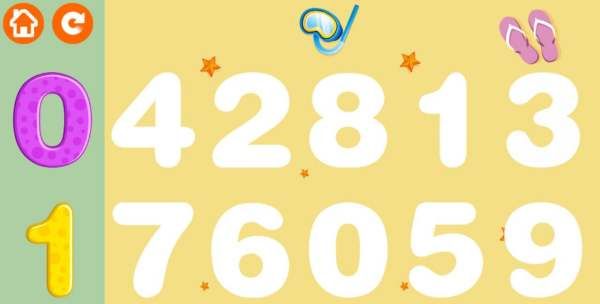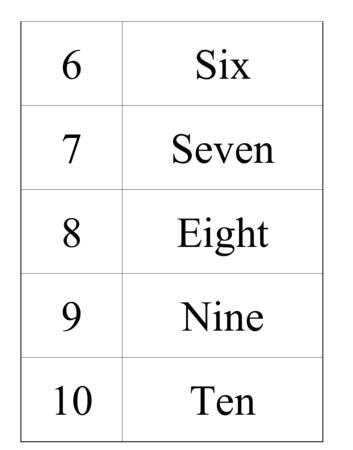本文目录
英语中数字到0的英文单词有哪些呢
一到二十的数字英语如下:
1.one 英 [wʌn] 美 [wʌn] n. 一;一个;一体
2.two 英 [tuː] 美 [tuː] num. 二;两个
3.three 英 [θriː] 美 [θriː] num. 三;n. 三;三个
4.four 英 [fɔː(r)] 美 [fɔːr] num. 四
5.five 英 [faɪv] 美 [faɪv] num. 五
6.six 英 [sɪks] 美 [sɪks] num. 六
7.seven英 ['sevn] 美 ['sevn] num. 七
8.eight 英 [eɪt] 美 [eɪt] num. 八;n. 八人划船队
9.nine 英 [naɪn] 美 [naɪn] num. 九
10.ten 英 [ten] 美 [ten] num. 十

扩展资料:
1-10的中文大写
壹、贰、叁、肆、伍、陆、柒、捌、玖、拾。
中文数字,是中文使用的数字系统,在阿拉伯数字传入前广泛使用。以中文的形式表示的数字在开具发票、收据的时候经常用到,尤其在金融领域。
东亚地区书写支票时仍会使用中文数字(通常是“大写”),因笔划繁复较难做假。但数字的中文表示和其它语言有很大的不同,如中文以每4个数字(万)为一个小的分隔。
数字的这种繁化写法,早在唐代就已经全面地使用了,后来逐步地规范化成一套“大写数码”。
参考资料:中国大写数字-百度百科

1,2,3,4,5,6,7,8九10的英文
1 one
2 two
3 three
4 four
5 five
6 six
7 seven
8 eight
9 nine
阿拉伯数字由0,1,2,3,4,5,6,7,8,9共10个计数符号组成,是现今国际通用数字。阿拉伯数字最初由古印度人发明,后由阿拉伯人传向欧洲,之后再经欧洲人将其现代化。正因阿拉伯人的传播,成为该种数字最终被国际通用的关键节点,所以人们称其为“阿拉伯数字”。

扩展资料:
罗马数字是欧洲在阿拉伯数字(实际上是印度数字)传入之前使用的一种数码,现在应用较少。它的产生晚于中国甲骨文中的数码,更晚于埃及人的十进制数字。但是,它的产生标志着一种古代文明的进步。
罗马数字是阿拉伯数字传入之前使用的一种数码。罗马数字采用七个罗马字母作数字、即Ⅰ(1)、X(10)、C(100)、M(1000)、V(5)、L(50)、D(500)。记数的方法:
1、相同的数字连写,所表示的数等于这些数字相加得到的数,如 Ⅲ=3;
2、小的数字在大的数字的右边,所表示的数等于这些数字相加得到的数,如 Ⅷ=8、Ⅻ=12;
3、小的数字(限于 Ⅰ、X 和 C)在大的数字的左边,所表示的数等于大数减小数得到的数,如 Ⅳ=4、Ⅸ=9;
4、在一个数的上面画一条横线,表示这个数增值 1,000 倍,如
 = =5000。
= =5000。
参考资料:百度百科——阿拉伯数字
百度百科——罗马数字
发00的英语单词
一、基数词
1 one
2 two
3 three
4 four
5 five
6 six
7 seven
8 eight
9 nine
10 ten
11 eleven
12 twelve
13 thirteen
14 fourteen
15 fifteen
16 sixteen
17 seventeen
18 eighteen
19 nineteen
20 twenty
21 twenty-one
22 twenty-two
23 twenty-three
30 thirty
32 thirty-two
40 forty
50 fifty
60 sixty
70 seventy
80 eighty
90 ninety
100 one hundred
二、序数词
first 第一
second 第二
third 第三
fourth 第四
fifth 第五
sixth 第六
seventh 第七
eighth 第八
ninth 第九
tenth 第十
eleventh 第十一
twelfth 第十二
thirteenth 第十三
fourteenth 第十四
fifteenth 第十五
sixteenth 第十六
seventeenth 第十七
eighteenth 第十八
nineteenth 第十九
twentieth 第二十
twenty-first 第二十一
twenty-second 第二十二
twenty-third 第二十三
thirtieth 第三十
thirty-first 第三十一
fortieth 第四十
fiftieth 第五十
sixtieth 第六十
seventieth 第七十
eightieth 第八十
ninetieth 第九十
(one)hundredth 第一百
三、拓展:常用数字英语单词大全
一、 数词的分类
1. 基数词
表示数目的词称为基数词。其形式如下:
A.从1——10
one,two,three,four,five,six,seven,eight,nine,ten.
B.从 11——19
eleven,twelve, thirteen, fourteen, fifteen, sixteen, seventeen,eighteen, nineteen.
这里除 eleven, twelve, thirteen, fifteen, eighteen为特殊形式外,fourteen,sixteen,seventeen,nineteen都是由其个位数形式后添加后缀-teen构成。
C.从 21——99
整数几十中除twenty,thirty, forty,fifty,eighty为特殊形式外,sixty,seventy,ninety都是其个位数形式后添加后缀-ty构成。表示几十几时,在几十和个位基数词形式之间添加连字符“-”
21 twenty-one
76 seventy-six
D.百位数
个数基数词形式加“hundred”,表示几百,在几十几与百位间加上and.
101 a hundred and one
320 three hundred and twenty
648 six hundred and forty-eight
E.千位数以上
从数字的右端向左端数起,每三位数加一个逗号“,”。从右开始,第一个“,”前的数字后添加 thousand,第二个“,”前面的数字后添加 million,第三个“,”前的数字后添加 billion。然后一节一节分别表示,两个逗号之间最大的数为百位数形式。
2,648 two thousand six hundred and forty-eight
16,250,064 sixteen million two hundred and fifty thousand sixty-four
5,237,166,234 five billion,two hundred and thirty-seven million,one hundred and sixty-six thousand,two hundred and thirty-four
F.基数词在表示确切的数字时,不能使用百、千、百万、十亿的复数形式;但是,当基数词表示不确切数字,如成百、成千上万,三三两两时,基数词则以复数形式出现。
There are hundreds of people in the hall.
大厅里有数以百计的人。
Thousands and thousands of people come to visit the Museum of Qin Terra-Cotta Warriors and Horses every day.
每天有成千上万的人来参观秦兵马涌博物馆。
They went to the theatre in twos and threes.
他们三三两两地来到了剧院。
G.表示人的不确切岁数或年代,用几十的复数形式表示。
He became a professor in his thirties.
他三十多岁时成为了教授。
She died of lung cancer in forties.
她四十来岁时死于肺癌。
It was in the 1960s.
那是在二十世纪六十年代。
H.基数词的句法功能
基数词在句中可作主语、宾语、定语、表语、同位语。
The two happily opened the box.
两个人高兴地打开了盒子。(作主语)
I need three altogether.
我总共需要三个。(作宾语)
Four students are playing volleyball outside.
四个学生在外面打排球。(作定语)
We are sixtteen.
我们是16个人。(作表语)
They three tried to finish the task before sunset.
他们三个人尽力想在日落前完成任务。(作同位语)
2. 序数词
表示顺序的词称为序数词。序数词的主要形式:
A.从第一至第十九
其中,one— first, two— second, three— third, five— fifth,eight—eighth,nine—ninth,twelve— twelfth为特殊形式,其它的序数词都是由其相对应的基数词后面添加“th”构成。例如: six— sixth、nineteen— nineteenth.
B.从第二十至第九十九
整数第几十的形式由其对应的基数词改变结尾字母y为i,再加“eth”构成。
twenty——twentieth thirty——thirtieth
表示第几十几时,用几十的基数词形式加上连字符“-”和个位序数词形式一起表示。
thirty-first 第三十一
fifty-sixth 第五十六
seventy-third 第七十三
ninety-ninth 第九十九
C.第一百以上的多位序数词
由基数词的形式变结尾部分为序数词形式来表示。
one hundred and twenty-first 第一百二十一
one thousand,three hundred and twentieth 第一千三百二十
D.序数词的缩写形式
有时,序数词可以用缩写形式来表示。主要缩写形式有。
first——lst second——2nd third——3rd
fourth——4th sixth——6th twentieth——20th
twenty-third——23rd
其中lst,2nd,3rd为特殊形式,其它的都是阿拉伯数字后加上th。
E.序数词的句法功能
序数词在句中可作主语、宾语、定语和表语。
The second is what I really need.
第二个是我真正需要的。(作主语)
He choose the second.
他挑选了第二个。(作宾语)
We are to carry out the first plan.
我们将执行第一个计划。(作定语)
She is the second in our class.在我们班她是第二名。(作表语)
注:序数词在使用时,通常前面要加定冠词 the;但是如果序数词前出现不定冠词a或an时,则表示“再——”,“又——”。
We''ll go over it a second time.
我们得再念第二遍。
We''ve tried it three times.Must we try it a fourth time?
我们已经试过三遍了,还必须试一次(第四次)吗?
另外,基数词也可以表示顺序。只需将基数词放在它所修饰的.名词之后即可,不需要添加定冠词。
the first lesson——Lesson One
the fifth page——Page 5(five)
the twenty-first room——Room 21(twenty-one)
二、时刻表示法
1. 表示几点钟用基数词加可以省略的o''clock
5:00 读作 five o''clock 或 five
2. 表示几点过几分,在分钟后加past,再加小时
five past seven 七点过五分
half past six 六点半
a quarter past eight 八点过一刻
seven past eight 八点过七分
3. 表示几点差几分,在分钟后面加to,再加小时
ten to eight 差十分八点(七点五十分)
a quarter to twelve 差一刻十二点(十一点四十五分)
twenty to six 差二十分六点(五点四十分)
在日常生活中,常用下列简单方法表示时间。
以小时、分种为单位分别读出数字。
6:31 读作 six thirty-one
10:26读作 ten twenty-six
14:03 读作 fourteen o three
16:15 读作 sixteen fifteen
18:30 读作 eighteen thirty
23:55 读作 twenty-three fifty-five
注:时刻表上的时间大多采用24小时表示法,这样就不需要用a.m.表示上午,p.m.表示下午了
三、年月表示法
1. 世纪可以用定冠词加序数词加世纪century表示,也可以用定冠词加百位进数加''s表示
the sixth(6th)century 公元六世纪
the eighteenth(18th)century 公元十八世纪
the 1900''s 二十世纪
the 1600''s 十七世纪
这里,用百位数整数表示的世纪比这一百位阿拉伯数字本身多一个世纪。
2. 年代用定冠词及基数词表示的世纪加十位整数的复数形式构成
in the 1930''s(in the thirties of the twentieth century或 in the nineteen thirties)
在二十世纪三十年代
in the 1860''s(in the sixties of the 19th century或 in the eighteen sixties)
在十九世纪六十年代
In the 1870''s when Marx was already in his fifties,he found it important to study the situation in Russia,so he began to learn Russian.
在十九世纪七十年代当马克思已经五十多岁时,他发现研究俄国的形势很重要,便开始学习俄语。
3. 表示某年代的早期、中期和晚期,可以在定冠词后,年代前添加 early,mid-,late
in the early 1920''s 在二十世纪二十年代早期
in the mid-1950''s 在二十世纪五十年代中期
4. 年月日表示法
A.年份用基数词表示,一般写为阿拉伯数字,读时可以以hundred为单位,也可以以世纪、年代为单位分别来读。
1949 读作 nineteen hundred and forty-nine 或 nineteen forty-nine
1800 读作 eighteen hundred
253 读作 two hundred and fifty-three或two fifty-three
1902 读作 nineteen hundred and two或 nineteen o two
表示在哪一年,一般在年数前加介词in,使用year时,year放在数词之前。
in the year two fifty-three B.C. 在公元前253年
但是,通常采用in加表示年份的阿拉伯数字。
B. 月份,在哪个月用介词in加第一个字母大写的月份词表示。例如:in May在五月; in July在七月。为了简便起见,月份与日期连用时,月份常用缩写形式表示。缩写形式除May,June,July外,其它的月份都由其前三个字母表示,但 September除外。
January——Jan.一月 February——Feb.二月
March——Mar. 三月 April——Apr.四月
August——Aug.八月
September——Sept.九月
October——Oct.十月
November——Nov.十一月
December——Dec.十二月
注:这里缩写形式后面加点不能省略,因为它是表示缩写形式的符号。
C.日期用定冠词the加序数词表示。在哪一天要添加介词on。
National Day is on Oct. 1.
国庆节是十月一日。(读作 October first)
此句也可以表示为 National Day is on the 1st of October.
May 5 五月五日(读作May fifth)
也可以表示为the fifth(5th)of May
Mar. 1(st) 三月一日(读作March first或 the first of March)
5. 表示不具体、不确切的时间,如世纪、年代、年份、月份时,用介词in表示,表示具体确切的某一天用介词on表示通常情况下 morning,afternoon,evening等词前用介词in。但是,当这些词前后有一修饰限定的词作为定语,把它们限定为某一天早晨、下午或晚上时,介词in应改为on。这里的修饰限定词可以是介词短语、名词、形容词、定语从句等。
On a cold morning,the old man died lonely in his house.
在一个寒冷的早晨,这个老人孤独地死在自己的房子里。
I don''t want to be disturbed on nights when I have to study.
我不愿意在我必须学习的晚上被打扰。
The accident happened on the afternoon of July 7.
这次事故发生在7月7日下午。
We are to have a small test on Monday morning.
星期一早晨我们将进行一次小测验。

以上就是关于常用数字英文单词表格 ,英语中数字到0的英文单词有哪些呢的全部内容,以及常用数字英文单词表格 的相关内容,希望能够帮到您。
